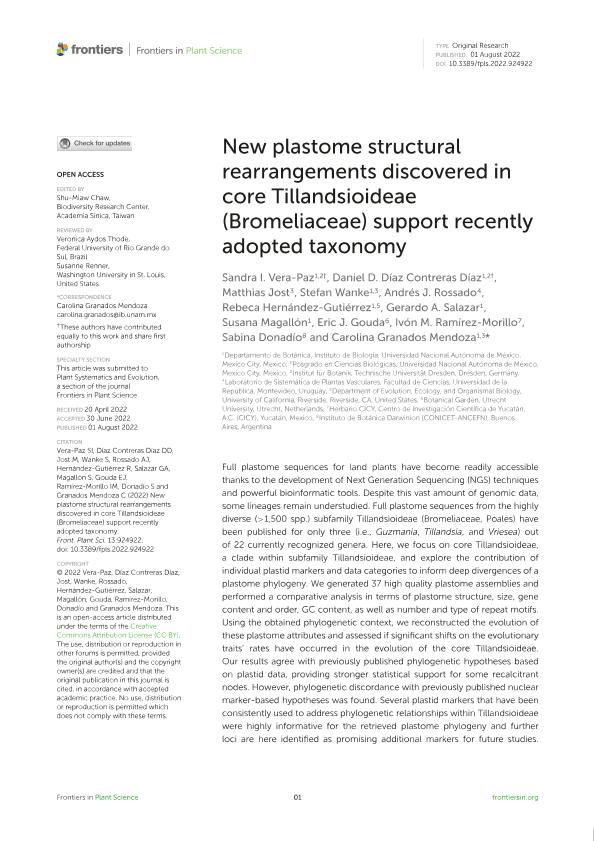Mostrar el registro sencillo del ítem
dc.contributor.author
Vera Paz, Sandra I.
dc.contributor.author
Díaz Contreras Díaz, Daniel D.
dc.contributor.author
Jost, Matthias
dc.contributor.author
Wanke, Stefan
dc.contributor.author
Rossado, Andrés J.
dc.contributor.author
Hernández Gutiérrez, Rebeca
dc.contributor.author
Salazar, Gerardo A.
dc.contributor.author
Magallón, Susana
dc.contributor.author
Gouda, Eric J.
dc.contributor.author
Ramírez Morillo, Ivón M.
dc.contributor.author
Donadío, Sabina

dc.contributor.author
Granados Mendoza, Carolina
dc.date.available
2024-01-16T12:51:10Z
dc.date.issued
2022-08
dc.identifier.citation
Vera Paz, Sandra I.; Díaz Contreras Díaz, Daniel D.; Jost, Matthias; Wanke, Stefan; Rossado, Andrés J.; et al.; New plastome structural rearrangements discovered in core Tillandsioideae (Bromeliaceae) support recently adopted taxonomy; Frontiers Media; Frontiers in Plant Science; 13; 8-2022; 1-19
dc.identifier.issn
1664-462X
dc.identifier.uri
http://hdl.handle.net/11336/223727
dc.description.abstract
Full plastome sequences for land plants have become readily accessible thanks to the development of Next Generation Sequencing (NGS) techniques and powerful bioinformatic tools. Despite this vast amount of genomic data, some lineages remain understudied. Full plastome sequences from the highly diverse (>1,500 spp.) subfamily Tillandsioideae (Bromeliaceae, Poales) have been published for only three (i.e., Guzmania, Tillandsia, and Vriesea) out of 22 currently recognized genera. Here, we focus on core Tillandsioideae, a clade within subfamily Tillandsioideae, and explore the contribution of individual plastid markers and data categories to inform deep divergences of a plastome phylogeny. We generated 37 high quality plastome assemblies and performed a comparative analysis in terms of plastome structure, size, gene content and order, GC content, as well as number and type of repeat motifs. Using the obtained phylogenetic context, we reconstructed the evolution of these plastome attributes and assessed if significant shifts on the evolutionary traits’ rates have occurred in the evolution of the core Tillandsioideae. Our results agree with previously published phylogenetic hypotheses based on plastid data, providing stronger statistical support for some recalcitrant nodes. However, phylogenetic discordance with previously published nuclear marker-based hypotheses was found. Several plastid markers that have been consistently used to address phylogenetic relationships within Tillandsioideae were highly informative for the retrieved plastome phylogeny and further loci are here identified as promising additional markers for future studies. New lineage-specific plastome rearrangements were found to support recently adopted taxonomic groups, including large inversions, as well as expansions and contractions of the inverted repeats. Evolutionary trait rate shifts associated with changes in size and GC content of the plastome regions were found across the phylogeny of core Tillandsioideae.
dc.format
application/pdf
dc.language.iso
eng
dc.publisher
Frontiers Media

dc.rights
info:eu-repo/semantics/openAccess
dc.rights.uri
https://creativecommons.org/licenses/by-nc-sa/2.5/ar/
dc.subject
ANCESTRAL STATE RECONSTRUCTION
dc.subject
EVOLUTIONARY RATE SHIFTS
dc.subject
GENE TRANSLOCATION
dc.subject
INVERSIONS
dc.subject
INVERTED REPEATS (IRS)
dc.subject
PHYLOGENETIC INFORMATIVENESS
dc.subject
PLASTOME
dc.subject.classification
Ciencias de las Plantas, Botánica

dc.subject.classification
Ciencias Biológicas

dc.subject.classification
CIENCIAS NATURALES Y EXACTAS

dc.title
New plastome structural rearrangements discovered in core Tillandsioideae (Bromeliaceae) support recently adopted taxonomy
dc.type
info:eu-repo/semantics/article
dc.type
info:ar-repo/semantics/artículo
dc.type
info:eu-repo/semantics/publishedVersion
dc.date.updated
2024-01-16T10:43:01Z
dc.journal.volume
13
dc.journal.pagination
1-19
dc.journal.pais
China

dc.journal.ciudad
Taiwan
dc.description.fil
Fil: Vera Paz, Sandra I.. Universidad Nacional Autónoma de México; México
dc.description.fil
Fil: Díaz Contreras Díaz, Daniel D.. Universidad Nacional Autónoma de México; México
dc.description.fil
Fil: Jost, Matthias. No especifíca;
dc.description.fil
Fil: Wanke, Stefan. Universidad Nacional Autónoma de México; México
dc.description.fil
Fil: Rossado, Andrés J.. Universidad de la Republica; Uruguay
dc.description.fil
Fil: Hernández Gutiérrez, Rebeca. Universidad Nacional Autónoma de México; México
dc.description.fil
Fil: Salazar, Gerardo A.. Universidad Nacional Autónoma de México; México
dc.description.fil
Fil: Magallón, Susana. Universidad Nacional Autónoma de México; México
dc.description.fil
Fil: Gouda, Eric J.. Utrecht University; Países Bajos. University of Utrecht; Países Bajos
dc.description.fil
Fil: Ramírez Morillo, Ivón M.. No especifíca;
dc.description.fil
Fil: Donadío, Sabina. Consejo Nacional de Investigaciones Científicas y Técnicas. Instituto de Botánica Darwinion. Academia Nacional de Ciencias Exactas, Físicas y Naturales. Instituto de Botánica Darwinion; Argentina
dc.description.fil
Fil: Granados Mendoza, Carolina. Universidad Nacional Autónoma de México; México
dc.journal.title
Frontiers in Plant Science
dc.relation.alternativeid
info:eu-repo/semantics/altIdentifier/url/https://www.frontiersin.org/articles/10.3389/fpls.2022.924922/full
dc.relation.alternativeid
info:eu-repo/semantics/altIdentifier/doi/http://dx.doi.org/10.3389/fpls.2022.924922
Archivos asociados
